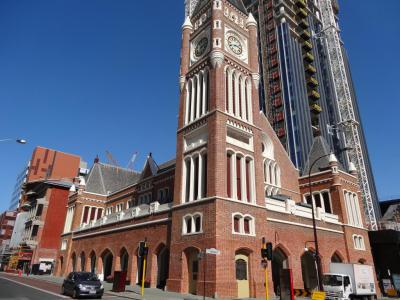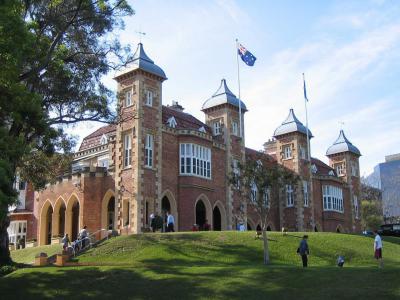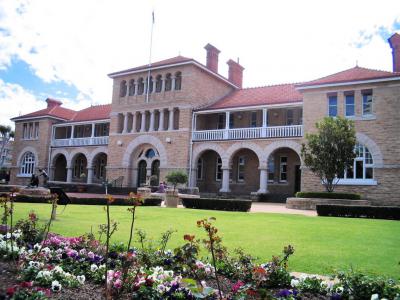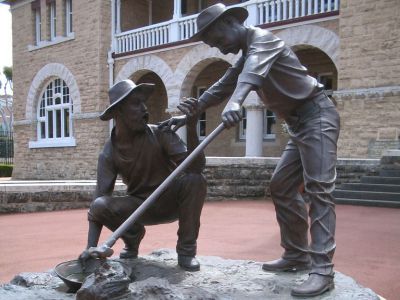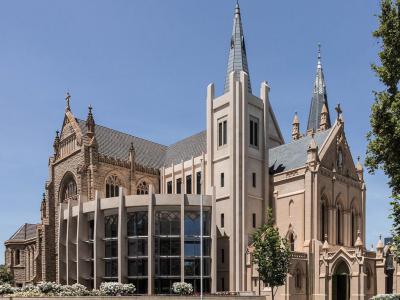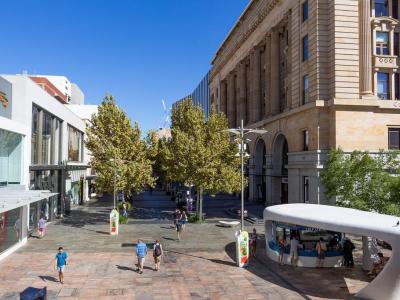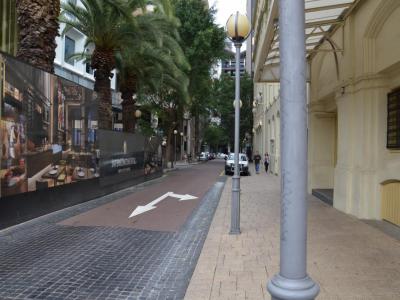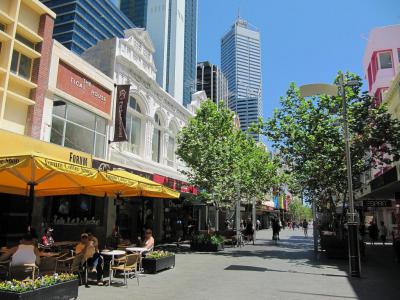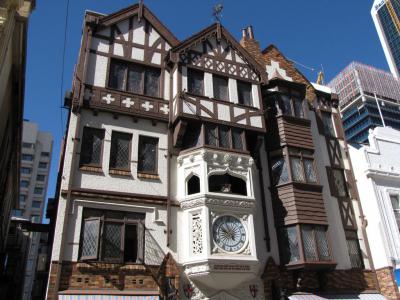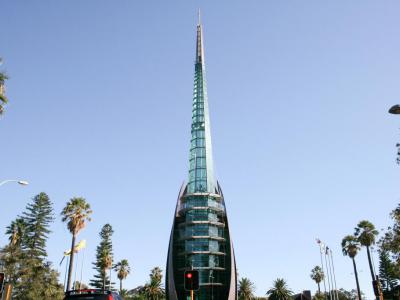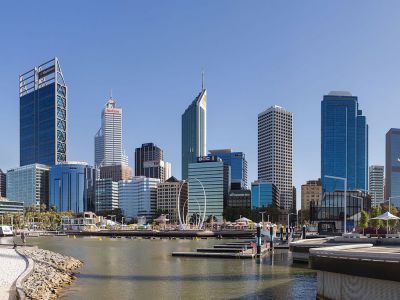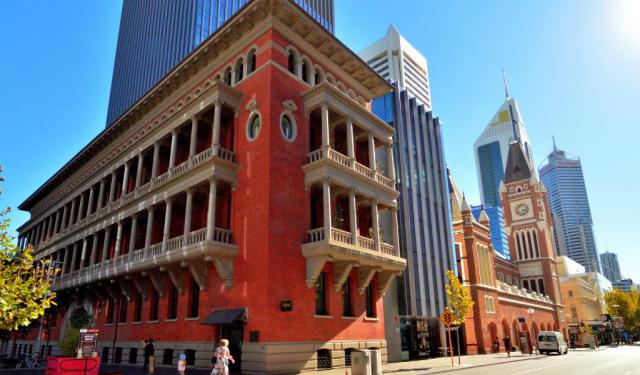Perth Introduction Walking Tour (Self Guided), Perth
Perth is the capital of Western Australia. With a population of more than 2 million, the metropolitan area is the fourth largest in the country.
Perth was founded by Captain James Stirling in 1829. It was the first free-settler colony in Australia established by private capital. The official foundation ceremony took place on 12 August 1829 with the chopping down of a tree. Today a plaque set in the footpath of Barrack Street marks the approximate location of the event.
The city was named after Perth, Scotland, birthplace of Sir George Murray who was the secretary of state for the colonies when Perth gained the city status in 1856. Prior to its settlement as a colony, the area of Perth was inhabited by the Noongar People who lived along the Swan Coastal Plain.
The first population growth came in 1849 when Perth received an influx of over 9000 convicts. The convicts constructed a large amount of infrastructure that shaped the early character of the city. The population stayed relatively small until the Gold Rush in 1892. This event marked a turning point in city's history and it has been immortalized via a statue, called "The Strike," which is located in front of the Perth Mint.
The city grew in even larger numbers after World War II when post-War immigrants flooded the area. Culture, industry and mining grew along with the steady increase of new residents. Buildings that were erected in the mid-19th century, such as the Government House, now share space with modern skyscrapers, like the Bell Tower.
Perth is a popular tourist destination due to its important place in Australian history and its many historic buildings. St. Mary's Cathedral and London Court are just two of the beautiful heritage buildings that visitors love to see. In addition, the city has a number of streets that have been partially transformed into pedestrian malls. Hay Street, King Street and Murray Street are all excellent spots for shopping, dining and admiring the historical architecture.
Perth has continued to develop areas to capitalize on tourism efforts. One of the most recent construction efforts is Elizabeth Quay. This area is a spot for both shopping and recreation as well as beautiful views of the river. Elizabeth Quay offers open-air art installations, a playground and spray ground for kids, ample dining opportunities and easy access to Perth downtown.
Take this self-guided walking tour to experience the beautiful sights that Perth has to offer.
Perth was founded by Captain James Stirling in 1829. It was the first free-settler colony in Australia established by private capital. The official foundation ceremony took place on 12 August 1829 with the chopping down of a tree. Today a plaque set in the footpath of Barrack Street marks the approximate location of the event.
The city was named after Perth, Scotland, birthplace of Sir George Murray who was the secretary of state for the colonies when Perth gained the city status in 1856. Prior to its settlement as a colony, the area of Perth was inhabited by the Noongar People who lived along the Swan Coastal Plain.
The first population growth came in 1849 when Perth received an influx of over 9000 convicts. The convicts constructed a large amount of infrastructure that shaped the early character of the city. The population stayed relatively small until the Gold Rush in 1892. This event marked a turning point in city's history and it has been immortalized via a statue, called "The Strike," which is located in front of the Perth Mint.
The city grew in even larger numbers after World War II when post-War immigrants flooded the area. Culture, industry and mining grew along with the steady increase of new residents. Buildings that were erected in the mid-19th century, such as the Government House, now share space with modern skyscrapers, like the Bell Tower.
Perth is a popular tourist destination due to its important place in Australian history and its many historic buildings. St. Mary's Cathedral and London Court are just two of the beautiful heritage buildings that visitors love to see. In addition, the city has a number of streets that have been partially transformed into pedestrian malls. Hay Street, King Street and Murray Street are all excellent spots for shopping, dining and admiring the historical architecture.
Perth has continued to develop areas to capitalize on tourism efforts. One of the most recent construction efforts is Elizabeth Quay. This area is a spot for both shopping and recreation as well as beautiful views of the river. Elizabeth Quay offers open-air art installations, a playground and spray ground for kids, ample dining opportunities and easy access to Perth downtown.
Take this self-guided walking tour to experience the beautiful sights that Perth has to offer.
How it works: Download the app "GPSmyCity: Walks in 1K+ Cities" from Apple App Store or Google Play Store to your mobile phone or tablet. The app turns your mobile device into a personal tour guide and its built-in GPS navigation functions guide you from one tour stop to next. The app works offline, so no data plan is needed when traveling abroad.
Perth Introduction Walking Tour Map
Guide Name: Perth Introduction Walking Tour
Guide Location: Australia » Perth (See other walking tours in Perth)
Guide Type: Self-guided Walking Tour (Sightseeing)
# of Attractions: 11
Tour Duration: 2 Hour(s)
Travel Distance: 4.2 Km or 2.6 Miles
Author: DanaOffice
Sight(s) Featured in This Guide:
Guide Location: Australia » Perth (See other walking tours in Perth)
Guide Type: Self-guided Walking Tour (Sightseeing)
# of Attractions: 11
Tour Duration: 2 Hour(s)
Travel Distance: 4.2 Km or 2.6 Miles
Author: DanaOffice
Sight(s) Featured in This Guide:
- Perth Town Hall and Perth Foundation Plaque
- Government House and Gardens
- Perth Mint
- The Strike
- St. Mary's Cathedral
- Murray Street
- King Street
- Hay Street
- London Court
- The Bell Tower
- Elizabeth Quay
1) Perth Town Hall and Perth Foundation Plaque
The Perth Town Hall stands out as the only town hall across Australia that was constructed with the help of convict labor. It was designed by Richard Roach Jewell and James Manning, showcasing the Victorian Free Gothic style, and its construction from 1867 to 1870 saw the involvement of both convicts and free individuals. Unique features of the hall include decorations inspired by convict life, such as window designs reminiscent of the broad arrow symbol and hangman's noose motifs.
The hall's cornerstone was set in place on May 24, 1867, by Governor Hampton during a lavish ceremony. Despite heavy rain, the event proceeded with a grand procession from the Government House and a staged battle by local military groups, demonstrating the community's resilience and spirit.
Perth's establishment goes back to 1829, credited to Captain James Stirling. The formal founding moment involved Mrs. Helen Dance cutting down a tree on August 12, 1829, a historical moment now marked by a plaque near the Town Hall.
Throughout the 20th century, the ground level of the Town Hall hosted a variety of businesses such as a pharmacy, bank, and various shops, offering the only public restrooms in the vicinity. These commercial entities and accompanying structures were cleared out before the early 2000s renovation.
For a long time, the Perth Town Hall was a key landmark in the city's civic landscape. Even today, it remains an impressive structure that continues to attract and fascinate visitors and locals alike.
The hall's cornerstone was set in place on May 24, 1867, by Governor Hampton during a lavish ceremony. Despite heavy rain, the event proceeded with a grand procession from the Government House and a staged battle by local military groups, demonstrating the community's resilience and spirit.
Perth's establishment goes back to 1829, credited to Captain James Stirling. The formal founding moment involved Mrs. Helen Dance cutting down a tree on August 12, 1829, a historical moment now marked by a plaque near the Town Hall.
Throughout the 20th century, the ground level of the Town Hall hosted a variety of businesses such as a pharmacy, bank, and various shops, offering the only public restrooms in the vicinity. These commercial entities and accompanying structures were cleared out before the early 2000s renovation.
For a long time, the Perth Town Hall was a key landmark in the city's civic landscape. Even today, it remains an impressive structure that continues to attract and fascinate visitors and locals alike.
2) Government House and Gardens
The Government House is the residence of the governor of Western Australia. Though the existing house was built in 1864, the site has been in use by governors of Western Australia since 1829 when the Swan River Colony was established. It is located on the primary thoroughfare in Perth near the Council House.
The house was built in the Jacobean Revival style from a design by Edmund Henderson. It was mostly built by convicts. Along with the house, a separate building called The Lodge was added in 1904 in the gardens. The Lodge is in the Federation Queen Anne architectural style.
The gardens at Government House consist of a meticulously crafted green space, shade trees, a walking path and outdoor art. The gardens are open to the public from 12 PM to 2 PM from Tuesday through Thursday.
The house and the gardens were listed on the Western Australian Register of Heritage Places in 2011.
The house was built in the Jacobean Revival style from a design by Edmund Henderson. It was mostly built by convicts. Along with the house, a separate building called The Lodge was added in 1904 in the gardens. The Lodge is in the Federation Queen Anne architectural style.
The gardens at Government House consist of a meticulously crafted green space, shade trees, a walking path and outdoor art. The gardens are open to the public from 12 PM to 2 PM from Tuesday through Thursday.
The house and the gardens were listed on the Western Australian Register of Heritage Places in 2011.
3) Perth Mint (must see)
The Perth Mint is the official gold bullion mint of Australia. The building was designed by architect George Temple-Poole. It was established in 1899.
The Perth Mint is well known for creating the world's most valuable coin, the Australian Kangaroo Gold Coin Series. This coin is also the largest and heaviest in the world. The coin is approximately 31 inches in diameter and nearly five inches thick. It is made from 99.99 percent pure gold and was valued at $53.5 million Australian dollars at the time of minting.
Along with gold bullion, silver, platinum and market gold are also minted on the premises. The mint also manufactures coins for investors and collectors. The mint refines nearly 80 percent of the gold and 30 pecent of the silver in Australia.
The Perth Mint is a popular destination for tourists. Visitors can view the Australian Kangaroo Gold Coin, take a tour of the mint itself, watch a live gold pour and see some of the largest gold and silver specimens in the world. At the entrance to the Perth Mint is the statue "The Strike," which features the original prospectors who discovered gold in Western Australia.
Tourists can also visit the Perth Mint Shop where they will find gold nuggets, bullion, coins and souvenirs for sale. Jewelry at the shop is made from precious metals along with gems like blue grey and pink diamonds. The shop is located in the historic building that was once used to receive gold deposits from prospectors.
The Perth Mint was added to the Western Australia Heritage Register in 2000.
The Perth Mint is well known for creating the world's most valuable coin, the Australian Kangaroo Gold Coin Series. This coin is also the largest and heaviest in the world. The coin is approximately 31 inches in diameter and nearly five inches thick. It is made from 99.99 percent pure gold and was valued at $53.5 million Australian dollars at the time of minting.
Along with gold bullion, silver, platinum and market gold are also minted on the premises. The mint also manufactures coins for investors and collectors. The mint refines nearly 80 percent of the gold and 30 pecent of the silver in Australia.
The Perth Mint is a popular destination for tourists. Visitors can view the Australian Kangaroo Gold Coin, take a tour of the mint itself, watch a live gold pour and see some of the largest gold and silver specimens in the world. At the entrance to the Perth Mint is the statue "The Strike," which features the original prospectors who discovered gold in Western Australia.
Tourists can also visit the Perth Mint Shop where they will find gold nuggets, bullion, coins and souvenirs for sale. Jewelry at the shop is made from precious metals along with gems like blue grey and pink diamonds. The shop is located in the historic building that was once used to receive gold deposits from prospectors.
The Perth Mint was added to the Western Australia Heritage Register in 2000.
4) The Strike
The Strike is a sculpture located outside the Perth Mint. The bronze statue was cast in 1991 by sculptor Greg James. It pays honor to the Gold Rush in Western Australia.
The statue depicts the discovery of gold by gold prospectors William Ford and Arthur Bayley. The two men had met while prospecting in Queensland and decided together to go to an area that is now Coolgardie. They found the nugget of gold that is featured in "The Strike" monument.
Due to their discovery, and subsequent find of more than 37 pounds of gold, they were rewarded 20 acres of land. Bayley's Reward mine was named for Arthur Bayley.
The sculpture was placed directly in front of the entrance of the Perth Mint after it was cast. Visitors can see the statue from the street, but entry to the Perth Mint grounds is required for a close look. The gates are open from 9 AM to 5 PM Monday through Saturday and 10 AM to 5 PM each Sunday.
Locals sometimes refer to the statue as "The Miners."
The statue depicts the discovery of gold by gold prospectors William Ford and Arthur Bayley. The two men had met while prospecting in Queensland and decided together to go to an area that is now Coolgardie. They found the nugget of gold that is featured in "The Strike" monument.
Due to their discovery, and subsequent find of more than 37 pounds of gold, they were rewarded 20 acres of land. Bayley's Reward mine was named for Arthur Bayley.
The sculpture was placed directly in front of the entrance of the Perth Mint after it was cast. Visitors can see the statue from the street, but entry to the Perth Mint grounds is required for a close look. The gates are open from 9 AM to 5 PM Monday through Saturday and 10 AM to 5 PM each Sunday.
Locals sometimes refer to the statue as "The Miners."
5) St. Mary's Cathedral (must see)
Saint Mary's Cathedral is a Roman Catholic cathedral in Victoria Square. It replaced the colony's first Roman Catholic church, Saint John's. The cathedral was designed by Joseph Ascione in the Norman Gothic architectural style.
The cathedral was constructed in three phases. The primary structure was completed in 1865. The second construction, completed in the 1920s, added a new transept and sanctuary. Mosaics in the sanctuary were patterned after designs from the Book of Kells. New stained glass windows were added, designed by John Hardman of the United Kingdom.
The final construction increased the size of the cathedral, added a second spire and included an underground parish center. During construction, the remains of the first bishops of Perth were found beneath the cathedral's floorboards. A permanent crypt for these bishops was then added to the architectural plans.
This construction was completed in 2009. The new design of the cathedral won three architectural design awards for its architect Peter M. Quinn.
The cathedral was constructed in three phases. The primary structure was completed in 1865. The second construction, completed in the 1920s, added a new transept and sanctuary. Mosaics in the sanctuary were patterned after designs from the Book of Kells. New stained glass windows were added, designed by John Hardman of the United Kingdom.
The final construction increased the size of the cathedral, added a second spire and included an underground parish center. During construction, the remains of the first bishops of Perth were found beneath the cathedral's floorboards. A permanent crypt for these bishops was then added to the architectural plans.
This construction was completed in 2009. The new design of the cathedral won three architectural design awards for its architect Peter M. Quinn.
6) Murray Street
Murray Street is one of the main roads within Perth's central business district. A portion of Murray Street was turned into Murray Street Mall, a pedestrian store with numerous stores and boutiques.
Some of the shops tourists will see at Murray Street Mall are Pandora, The Body Shop, Swarovski and a number of local clothing, jewelry, shoe and souvenir stores. Murray Street Mall also offers many spots for drinks, dining and people watching.
Murray Street was named after Sir George Murray, former Secretary of State for War and the Colonies. Due to the street's long history within the city, it is home to several historic buildings. The Young Australia League Building and House is an Inter-War Free Classical style building constructed in 1905.
Across from the Young Australia League Building and House is a 19th century home that once belonged to philanthropist Timothy Quinlan. The Wentworth Hotel, on the corner of William and Murray Streets, has been in place for more than 100 years. It is a Heritage listed building due to its important contribution to Perth's history and culture.
Some of the shops tourists will see at Murray Street Mall are Pandora, The Body Shop, Swarovski and a number of local clothing, jewelry, shoe and souvenir stores. Murray Street Mall also offers many spots for drinks, dining and people watching.
Murray Street was named after Sir George Murray, former Secretary of State for War and the Colonies. Due to the street's long history within the city, it is home to several historic buildings. The Young Australia League Building and House is an Inter-War Free Classical style building constructed in 1905.
Across from the Young Australia League Building and House is a 19th century home that once belonged to philanthropist Timothy Quinlan. The Wentworth Hotel, on the corner of William and Murray Streets, has been in place for more than 100 years. It is a Heritage listed building due to its important contribution to Perth's history and culture.
7) King Street
King Street is one of the oldest streets in Perth. It was first recorded in 1840 on the maps of the Land Department under the name King William Street. The street was likely named after King William IV.
King Street is mostly known as a shopping destination along with two of the streets it crosses, Murray Street and Hay Street. King Street is primarily known as a spot for high-end, luxury goods. Shops on King Street include Louis Vuitton, Gucci, Chanel, Prada, Tiffany & Company and many others.
The street retains its 19th century atmosphere with its cobbled streets and traditional building facades. Brick storefronts, arched windows and doors, wrought iron gates and globed street lamps give tourists a taste of what life might have been like in the earliest days of Perth.
King Street is listed with the Heritage Council of Western Australia due to its important place in the region's history.
King Street is mostly known as a shopping destination along with two of the streets it crosses, Murray Street and Hay Street. King Street is primarily known as a spot for high-end, luxury goods. Shops on King Street include Louis Vuitton, Gucci, Chanel, Prada, Tiffany & Company and many others.
The street retains its 19th century atmosphere with its cobbled streets and traditional building facades. Brick storefronts, arched windows and doors, wrought iron gates and globed street lamps give tourists a taste of what life might have been like in the earliest days of Perth.
King Street is listed with the Heritage Council of Western Australia due to its important place in the region's history.
8) Hay Street
Hay Street is a main business street in Perth. A section of the street, between Barrack and William Streets, is a pedestrian mall. It was converted into a pedestrian mall in 1972. It was the first of its kind in the city.
Hay Street is notable for shopping as well as its historic buildings. Those who visit the street will notice a large number of notable structures along Hay Street.
The Gledden Building is an important feature of Perth's early architecture. It is an Art Deco building constructed in 1938 that was inspired by the skyscrapers of New York City and Chicago. His Majesty's Theatre is an Edwardian Baroque theatre built in 1904. Other important buildings on the street include London Court, Pert Town Hall, the City of Perth Library, Ross Memorial Church and many others.
Hay Street was named after Robert William Hay. Hay was the Permanent Under Secretary for Colonies from 1825 to 1836.
Hay Street is notable for shopping as well as its historic buildings. Those who visit the street will notice a large number of notable structures along Hay Street.
The Gledden Building is an important feature of Perth's early architecture. It is an Art Deco building constructed in 1938 that was inspired by the skyscrapers of New York City and Chicago. His Majesty's Theatre is an Edwardian Baroque theatre built in 1904. Other important buildings on the street include London Court, Pert Town Hall, the City of Perth Library, Ross Memorial Church and many others.
Hay Street was named after Robert William Hay. Hay was the Permanent Under Secretary for Colonies from 1825 to 1836.
9) London Court
London Court is an open-roofed shopping arcade on Hay Street. It was built by businessman Claude de Bernales in 1937. Though originally built with both commercial and residential properties in mind, it is now primarily a shopping and tourism destination.
Prior to the arcade's construction, the area was owned by Mayor Thomas Molloy. The series of alleys, called Gun Alley, was purchased by de Bernales in 1935. He hired architect Bernard Evans to design the building, which was crafted using modern conveniences like a dedicated laundry service and air conditioning.
The shopping arcade has a mock-Tudor/Elizabethan architectural design. It offers large, wrought-iron gates and a mechanized clock at each entrance. The clocks strike every 15 minutes with a mechanical display of jousting knights at one end and Saint George battling a dragon at the other.
The importance of London Court is reflected in its standing with the Australian government as a protected, historic building. London Court received a National Trust of Australia classification in 1978. It was added to the Register of the National Estate in 1982. It was added to the State Heritage Register of the Heritage Council of Western Australia in 1996.
Prior to the arcade's construction, the area was owned by Mayor Thomas Molloy. The series of alleys, called Gun Alley, was purchased by de Bernales in 1935. He hired architect Bernard Evans to design the building, which was crafted using modern conveniences like a dedicated laundry service and air conditioning.
The shopping arcade has a mock-Tudor/Elizabethan architectural design. It offers large, wrought-iron gates and a mechanized clock at each entrance. The clocks strike every 15 minutes with a mechanical display of jousting knights at one end and Saint George battling a dragon at the other.
The importance of London Court is reflected in its standing with the Australian government as a protected, historic building. London Court received a National Trust of Australia classification in 1978. It was added to the Register of the National Estate in 1982. It was added to the State Heritage Register of the Heritage Council of Western Australia in 1996.
10) The Bell Tower (must see)
The Bell Tower is a 271-foot tower that is home to 18 bells known as the Swan Bells. The copper and glass building was designed by architectural firm Hames Sharley. The tower was specifically created to withstand the ringing of the bells, which have a combined weight of nine tons.
Along with a six-story bell chamber made with reinforced concrete, the Bell Tower uses soundproof doors and window covers. This helps to muffle the sound of the bells or redirect the chimes as needed.
The bells themselves are referred to as the Swan Bells due to the building's proximity to the Swan River. They consist of a set of 12 bells from Saint Martin-in-the-Fields church in Trafalgar Square, London. The other six were cast by the Whitechapel Bell Foundry using metals mined in Western Australia. The Swan Bells are the second largest set of change ringing bells in the world.
Along with a six-story bell chamber made with reinforced concrete, the Bell Tower uses soundproof doors and window covers. This helps to muffle the sound of the bells or redirect the chimes as needed.
The bells themselves are referred to as the Swan Bells due to the building's proximity to the Swan River. They consist of a set of 12 bells from Saint Martin-in-the-Fields church in Trafalgar Square, London. The other six were cast by the Whitechapel Bell Foundry using metals mined in Western Australia. The Swan Bells are the second largest set of change ringing bells in the world.
11) Elizabeth Quay (must see)
Elizabeth Quay is an area on the north shore of Perth Water. The quay has been created as a mixed-use development that includes residential space, offices, shopping and entertainment. The development was designed by the architectural firm ARM Architecture.
It was named in honor of Queen Elizabeth II for her Diamond Jubilee. Its official opening took place in 2016 though new developments are still under way.
Visitors to Elizabeth Quay will find structures like the Bell Tower, Elizabeth Quay Bridge, The Island Playground and a carousel. A water park is open at Elizabeth Quay during the summer months.
The area is home to many pieces of public art that include a 95-foot tall abstract sculpture called "Spanda." Another popular work is "First Contact," which features a 16-foot tall bird standing in a boat by the shoreline.
Elizabeth Quay also features a bronze statue of Bessie Mabel Rischbieth. This statue honors the environmentalist who fought for conservation of the Swan River.
It was named in honor of Queen Elizabeth II for her Diamond Jubilee. Its official opening took place in 2016 though new developments are still under way.
Visitors to Elizabeth Quay will find structures like the Bell Tower, Elizabeth Quay Bridge, The Island Playground and a carousel. A water park is open at Elizabeth Quay during the summer months.
The area is home to many pieces of public art that include a 95-foot tall abstract sculpture called "Spanda." Another popular work is "First Contact," which features a 16-foot tall bird standing in a boat by the shoreline.
Elizabeth Quay also features a bronze statue of Bessie Mabel Rischbieth. This statue honors the environmentalist who fought for conservation of the Swan River.
Walking Tours in Perth, Australia
Create Your Own Walk in Perth
Creating your own self-guided walk in Perth is easy and fun. Choose the city attractions that you want to see and a walk route map will be created just for you. You can even set your hotel as the start point of the walk.
Perth Historic Buildings Walk
Established by British settlers in 1829 and originally named the Swan River Colony, the city of Perth boasts a wealth of old buildings – governmental, religious, residential, commercial and institutional, – many of which are heritage-listed.
Just like other Western Australia’s settlements, the city struggled throughout the 1800s from the lack of resources, labor and investment. However,... view more
Tour Duration: 2 Hour(s)
Travel Distance: 3.3 Km or 2.1 Miles
Just like other Western Australia’s settlements, the city struggled throughout the 1800s from the lack of resources, labor and investment. However,... view more
Tour Duration: 2 Hour(s)
Travel Distance: 3.3 Km or 2.1 Miles
The Most Popular Cities
/ view all



